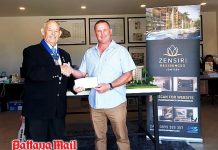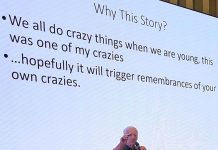Flu shots were available at the Pattaya City Expats Club (PCEC) meeting on Sunday, October 21. Gavin Waddell, head of the Phyathai Sriracha Hospital International Department, is also a PCEC member and arranged to have a nurse and an ample supply of this year’s flu vaccine available for members and guests. The cost was 990 baht, the same price charged at the hospital.
He noted that this year’s vaccine was a three in one. It provided protection from the seasonal flu, influenza type B, and H1N1. He also brought Dr. Somboon Jirapattrathamrong, M.D. an Intervention Cardiologist from the hospital, to talk to the PCEC about coronary heart disease along with another nurse to give free blood pressure checks.
 PCEC’s membership director, Judith Edmonds, gives the quarterly membership report.
PCEC’s membership director, Judith Edmonds, gives the quarterly membership report.
Dr. Somboon started by presenting a diagram of the heart and explaining how the heart arteries carry blood to supply oxygen and needed nutrients to the heart muscle. Using additional animated diagrams, he described how plaque can build up within the heart artery cutting off this flow of blood. If the narrowing of the artery becomes too severe, it will cause chest pain (angina). The pain is usually in the middle of the chest and can radiate outward to the left shoulder and arm. It can also result in an acute myocardial infarction; more commonly known as a heart attack. This results when the flow of blood decreases below a critical threshold.
The risk is higher for males and for older people. Other high risk factors are diabetes, hypertension, or hyperlipidemia (increased levels of lipids – fats – in the blood, including cholesterol and triglycerides). Also, smoking, obesity, and a family history of heart disease places you in the high risk category. He said that the more of these risk factors you have, the greater the chance you will develop coronary heart disease.
He then described several noninvasive diagnostic tests available such as electrocardiogram (EKG), echocardiogram, exercise stress test, and CT scanning. But, he said the most definitive test is a coronary angiogram. Angiogram and angioplasty are performed in hospitals that have a catheterization laboratory. The procedure for a diagnostic angiogram is to insert a catheter through an artery into the heart chamber to release a dye; the dye is pumped through the arteries. The doctor views a monitor which shows the flow of the dye through the arteries; thus allowing the doctor to identify any area where the flow is constricted.
 Dr. Somboon Jirapattrathamrong, M.D. an Intervention Cardiologist with the Phyathai Sriracha Hospital, advises PCEC members on the nature and causes of CHD (Coronary Heart Disease). He then advised lifestyle changes that can help reduce incidence of CHD, including not smoking, eating lots of fruit & vegetables and little fried food, and consuming alcohol in moderation.
Dr. Somboon Jirapattrathamrong, M.D. an Intervention Cardiologist with the Phyathai Sriracha Hospital, advises PCEC members on the nature and causes of CHD (Coronary Heart Disease). He then advised lifestyle changes that can help reduce incidence of CHD, including not smoking, eating lots of fruit & vegetables and little fried food, and consuming alcohol in moderation.
He mentioned that in the past, it was customary to use the femoral artery entering from the groin area. However, many cardiologists have switched to using the radial artery entering from the wrist. When using the femoral artery, the patient must remain in bed for several hours to avoid the risk of bleeding from the area of the incision. The risk of bleeding from the incision is lessened when using the radial artery since the wrist can be immobilized, which allows the patient to get up and move about not long after the procedure.
If one or more severe blockages are found in the heart arteries, the next step most likely will be an angioplasty. In this procedure, a wire with a deflated balloon is inserted into the catheter and guided to the place where the artery wall has narrowed. The balloon is inflated, crushing the fatty deposits and opening up the blood vessel for improved flow. The balloon is then deflated and withdrawn. Very often a stent is used to ensure the artery remains open. Dr. Somboon showed an automated diagram as he described how a stent (wire mesh) is placed over the balloon before it is inserted. When the balloon is inflated, the wire mesh expands and remains in place when the balloon is deflated ensuring the artery remains open.
Dr. Somboon concluded by providing some lifestyle changes that can reduce your risk of coronary heart disease: quit smoking, reduce your alcohol intake, improve your diet by eating certain foods and not eating others that are high in cholesterol, exercise, and lose weight.
After Dr. Somboon answered several questions from the audience, Master of Ceremonies Richard Silverberg provided an update on upcoming events and called on Jerry Dean to conduct the Open Forum where questions are asked and answered about expat living in Thailand; Pattaya in particular. You can learn more about the PCEC and its many activities by visiting their website at www.pattayacityexpatsclub.com.
 Phyathai Sriracha Hospital’s Gavin Waddell (also a PCEC member) discusses the seasonal flu injections available, along with free blood pressure checks.
Phyathai Sriracha Hospital’s Gavin Waddell (also a PCEC member) discusses the seasonal flu injections available, along with free blood pressure checks.




